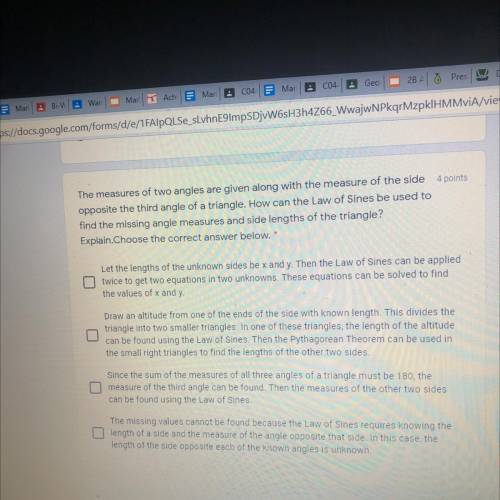
Mathematics, 28.02.2021 14:00 gigioschoch
The measures of two angles are given along with the measure of the side 4 points
opposite the third angle of a triangle. How can the Law of Sines be used to
find the missing angle measures and side lengths of the triangle?
Explain. Choose the correct answer below. *
Let the lengths of the unknown sides be x and y. Then the Law of Sines can be applied
twice to get two equations in two unknowns. These equations can be solved to find
the values of x and y.
Draw an altitude from one of the ends of the side with known length. This divides the
triangle into two smaller triangles. In one of these triangles, the length of the altitude
can be found using the Law of Sines. Then the Pythagorean Theorem can be used in
the small right triangles to find the lengths of the other two sides.
Since the sum of the measures of all three angles of a triangle must be 180, the
measure of the third angle can be found. Then the measures of the other two sides
can be found using the Law of Sines.
The missing values cannot be found because the Law of Sines requires knowing the
length of a side and the measure of the angle opposite that side. In this case, the
length of the side opposite each of the nown angles is unknown.


Answers: 2
Another question on Mathematics

Mathematics, 21.06.2019 15:00
What is the slope simplify your answer and write it as a proper fraction, improper fraction, or integer
Answers: 2

Mathematics, 21.06.2019 17:00
The center of a circle represent by the equation (x+9)^2+(y-6)^2=10^2 (-9,6), (-6,9), (6,-9) ,(9,-6)
Answers: 1

Mathematics, 21.06.2019 20:00
The function models the number of accidents per 50 million miles driven as a function
Answers: 1

Mathematics, 21.06.2019 21:50
What is the next step in the given proof? choose the most logical approach. a. statement: m 1 + m 2 + 2(m 3) = 180° reason: angle addition b. statement: m 1 + m 3 = m 2 + m 3 reason: transitive property of equality c. statement: m 1 = m 2 reason: subtraction property of equality d. statement: m 1 + m 2 = m 2 + m 3 reason: substitution property of equality e. statement: 2(m 1) = m 2 + m 3 reason: substitution property of equality
Answers: 3
You know the right answer?
The measures of two angles are given along with the measure of the side 4 points
opposite the third...
Questions

Mathematics, 20.08.2019 05:20

Mathematics, 20.08.2019 05:20

Arts, 20.08.2019 05:20








Physics, 20.08.2019 05:20


Computers and Technology, 20.08.2019 05:20










